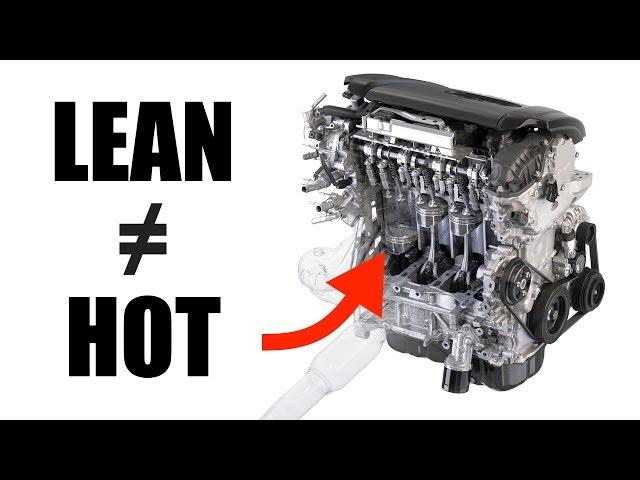
Why Lean Engines Do NOT Run Hot - Myth Busted
Комментарии:

Hi, could you also make a video about rich running engines? Some time ago I flashed the ECE on my bike to make the throttle response smoother, but now I'm curious if that creates some build up on the valves and other parts of the engine reducing the lifetime of the engine.
Ответить
This is not right. The lean combustion means the engine runs hotter.
Ответить
This just blew my mind. Thank you
Ответить
Hi Jason. Love your videos. Can you please explain to me why a cold engine requires a rich mix to start. Never understood it and nobody can explain it. Thanks a million.
Ответить
Bro made a nine minute video that says absolutely nothing💀if lean mixtures ran cooler, engines wouldn't be exploding because of it
Ответить
Did I miss the explanation he says it doesn't but the graph on the right clearly shows it does and I have seen a melted piston
Ответить
How is it possible that special Racecars run 20:1 or leaner with 3 Bar off Boost to get enough Laps with one Tank of fuel? I have seen a lot of Videos in German they say the Lean mixture runs without problems in racecars. Thank you!
Ответить
So how does a lean running 2 stroke burn holes in pistons? And a friends car was set slightly lean at altitude - and driving at sea level burned a hole in the exhaust manifold - not caused by knock. And do you remember the "lean burn" engines from the 70s/80s? They were designed to burn the Carbon Monoxide that normally goes out the exhaust (or used to). They changed to lean burn when enough temperature to fire the "very" lean mixture. I remember a motorcycle speed record set years ago using very "lean" carburetion. Bike had to be towed a couple of miles to heat up enough to fire up - again burning carbon monoxide - so no carbon monoxide out the exhaust.
Ответить
Hey Jason: Why do owners' manuals say not to use full throttle?
Ответить
Love this video explanation. However, you are definitely going against the grain. The far majority of the tuner/automotive engine crowd is of the thought that lean = running hot and potential for engine damage. You are definitely fighting against the myth and I love it. Now if you were to keep your engine temps cooler you have two options. 1. more fuel or 2. more air. Air is free.
Ответить
What about lean from E85, will engine explode?
Ответить
This is a 9 minute video and I already know what he's going to say.
"stoich is the hottest you can get. Lean is more air, and therefore more cooling than stoich. Myth busted"
However "running lean" doesn't mean running a ratio on the air-heavy side of stoich. It means you're closing in on stoich and getting hotter and hotter.
you're running LEANER than you want, and therefore HOTTER

My tuner has my car idle at 14.2 because of modern gas having more ethanol content in it. Would this change the stoimetric rating? Or just running richer for this fuel content.
Ответить
You can draw all the cartoon pictures you want to explain this using every bit of science you can think of. But out here in the real world.......because I've seen it many times.............a lean engine can (and usually does) actually run hotter. I just had a Ford 5.4L in my shop with a low fuel pressure issue. The codes in it were for lean running conditions for bank 1 and 2. Its also had codes P1299 and P1285 (Cylinder head temps to high). The customer also told me that the coolant temp gauge was up way higher than it usually is. We fixed the fuel issue and the high cylinder head temp codes did not come back. This is just one example of many that I've seen.
Ответить
So I guess this raises the question, why do exhaust pipes get red hot from running lean?
Ответить
you sound like a guy who never seen melted piston due to long run on lean mixture.
Ответить
Hello @engineering explained do i need an afr gauge if the car is non turbo? im thinking to put one since the car is scheduled for a dyno.
Ответить
So...... lean engines do NOT run hot ...... less rich ones do
Ответить
AFR is such a strange topic. i get comments responding to mine saying 14.7 is way too lean and i should be running 12. but then i watch videos and do my own research and 12 is alright but only under high boost, and in NA applications it’s a little rich.
PLEASE HELP. my understanding of the video is that 14.7 is good, but something like 13 would be ideal. anything over 15 is bad, not because it overheats, but because knock will occur.
is a lean idle dangerous? when i start my car the AFR is a little variable, ranging from 14-20. ONLY during idle. i never hit higher than 14.7 and under load my AFR drops to 12ish. My understanding is that my tune is safe and good, but other commenters have told me 14.7 is too lean.

Hey Jason, This Video make my friend think he can run his car engine at 30:1 afr and still can keep the engine cool and wont harm the engine. He trusted you 100%
Ответить
In a lean burn engine scenario, what is the advantage of running a 15:1 VS let's say a 17:1 ratio. I've even heard of some lean burn engines running a 20:1 ratio. It seems that adding any more air above and beyond 14.7:1 wouldn't provide any additional combustion benefits such as helping to ignite all available fuel. If anything, it would make the mixture less dense and make it more difficult to ignite since the fuel molecules are spaced further apart.
Ответить
I'm sorry but this video seems absolutely incorrect and a reason for this is because I believe when engines run lean, they get hot because there is too much more air than fuel in the engine which makes the flame hotter.
Ответить
The first thing that came to mind is that you have to set engine tuning aside.
Stock engine is built to run around 14:1 and it will survive. But if you have for example a 9:1 compression ratio and put like 1,5bar of boost on it, it will fail due to hot combustion. By running lean in tuning prospective is running above 13:1 which is not lean in normal cases.
Edit you mentioned my point in the end.

You're talking combustion temperature near TDC. Lean burn without added ignition advance fires off too late, heats the cylinder walls and exhaust valves, shows up as water temp (in marginal cooling systems), torched valves and glowing exhaust manifolds.
Ответить
I am viewing this video from the point of view of a general aviation pilot (in flight sims only!!!). For MOST piston aircraft the mixture is left up to the pilot. Full rich for takeoffs and landings, and since most of them are air cooled, the mixture is set to control Exhaust Gas Temp and Cylinder Head Temp. For climbing, somewhat rich, and for eco-cruise, somewhat lean of peak temp. Pull the mixture control out until just past peak EGT. The engine cruising is making less heat due to the throttle setting being reduced after climbing, so lean of peak doesn't cause overheating of the cylinder head. I think some planes have automated this, and I feel all should! The pilot already has enough to do! This needs to be adjusted constantly as the plane climbs higher. ( The higher you climb, but more you need to pull the control out.)
I had my Prius Prime up to 14,??? feet at Pike's Peak, and never had to adjust anything. 15K' is the ceiling for most naturally aspirated piston aircraft, so my Prius outclimed most of them with no adjustments on my part. (Or in any car!). Of course no cars currently sold that I know of are still air cooled as most GA aircraft are. The Cessna 152 starts struggling at 5K' (in my sim, I have never flown any plane IRL). My Cessna 182 Turbo craps out at around 22K, but is way happy over 15K. Very necessary flying in Papua and Papau New Guinea, or Chile.

I am viewing this video from the point of view of a general aviation pilot (in flight sims only!!!). For MOST piston aircraft the mixture is left up to the pilot. Full rich for takeoffs and landings, and since most of them are air cooled, the mixture is set to control Exhaust Gas Temp and Cylinder Head Temp. For climbing, somewhat rich, and for eco-cruise, somewhat lean of peak temp. Pull the mixture control out until just past peak EGT. The engine cruising is making less heat due to the throttle setting being reduced after climbing, so lean of peak doesn't cause overheating of the cylinder head. I think some planes have automated this, and I feel all should! The pilot already has enough to do! This needs to be adjusted constantly as the plane climbs higher. ( The higher you climb, but more you need to pull the control out.)
I had my Prius Prime up to 14,??? feet at Pike's Peak, and never had to adjust anything. 15K' is the ceiling for most naturally aspirated piston aircraft, so my Prius outclimed most of them with no adjustments on my part. (Or in any car!). Of course no cars currently sold that I know of are still air cooled as most GA aircraft are. The Cessna 152 starts struggling at 5K' (in my sim, I have never flown any plane IRL). My 182 Turbo craps out at around 22K, but is way happy over 15K. Very necessary flying in Papua and Papau New Guinea, or Chile.

Will deleting catalytic converters and using spark plug anti foulers as spacers to pull the upstream o2 sensor away from the flow of exhaust gasses cause my engine to run lean?
Ответить
True sorta, but there is the total ingredients in the cylinder vs what it's actually burning at. If the engine is freezing cold, the gas actually condenses and doesn't want to evaporate, so you may have X_amount of fuel in there, but it's not evaporated in the air, so you are actually burning lean, hence needing to choke/enrichen to get the afr back to a range where it can actually burn.
I'll repeat that: the choke/enrichener is needed to get the AFR back into a consistently burnable range, because it's not how much fuel is in the cylinder, it's how much is evaporating in the air.
Also, epa: how about we set our afr to run these engines as freakishly hot as possible to save a miniscule amount of fuel...
Thanks epa, we wanted to be so close to the limit that a tiny air leak melts a cylinder - because we care about the environment.
If you look at that heat curve, richening away from epa 14.7:1 improves your power and makes your engine run cooler, all to avoid something that natural plants just sitting on their own are the largest atmospheric producer thereof. And you can't burn the plants or have a forest fire, because that also releases it. And if neither of those happen, then bacteria releases it as it breaks down the plant matter. So basically, you can't stop it, it's a cycle/system, and the supposed efforts to stop it all end up creating the very thing they are trying to avoid, but mask it from being obvious.

Pressure and Mass Fraction vs. Rotation.
Otherwise known as the “sweet spot”.
Ignition timing for power when lean means more advance in the ignition timing. Why?
Because, leaner mixtures burn much slower. Therefore, the sweet spot just past TDC needs to have more ignition advance so, the pressure is present at the same time as it would have been. It’s the other side of the equation.
If you do one thing(leaning the mixture)one must consider the other changes this creates and allow for it. In this case it’s more advance for the ignition event.
David Vizard Performance has stuff on this.
You guys will love it.

Just to clarify, it sounds like we say that running rich or lean of stoich reduces the maximum temp but running lean under LOAD will increase temp because it's where the enging running the richest thus if allowed to use all the fuel will run potentially much hotter than at cruise. So both statements are true...runnung lean can be both cool or hot but depends if the engine is under load or not (in reference to a stock tune)
Ответить
yes, but it will have an effect, depending on the compression ratio. Especially on older engine designs leaking VVT and EGR systems.
Ответить
If leaning an engine out does not raise cylinder temps, how does the cylinder get hot enough to cause denotation ?
Ответить
How come CNG and propane don't damage the engine, but they are very lean fuels? I read that running a engine too lean will damage it.
Ответить
what would happen if you aerate the fuel before entering the cylinders
Ответить
Need to show this to my classic mercedes engine...
Ответить
This is wrong lean running will cause overheating he has got the Graph backwards. He is mad saying this.
Ответить
I was modeling an engine trying to use boost/back pressure rather than throttle to moderate output and it kept showing that if it went lean, it actually ran cooler at the exhaust, even if it was compressing more air at a high CR. Hence, I found your video for a second opinion. Thanks!
Ответить
How do you know there is some air left in combustion chamber at 14:7 ratio?
Ответить
Lean moxture means more air, more air in cylinder means higher pressure when piston compressing, higher pressure means higher temp.. i dont know man everywhere else ppl say lean mixtures are higher in effiency and temperatures, well ofc higher in thermal efficiency due to the face that you are reaching higher temps..
Ответить
My crx that I built with a d15z1 can stretch out to 24 to 1. Been getting over 60 mpg.
Ответить
There's a flaw somewhere in your data. True lean mixture won't create 'peak' temperature, but it's also reflected in power decline as well. But it is not the same as an EGR system. You said it yourself, EGR introduces insert gasses to the chamber. Air is not inert, that's why it burns. EGR system displaces air and fuel partially filling the chamber, thus creating a smaller flame front and reduced NOx. Running lean/hot means for the situation (that may be what confuses people), a car engine under load needs a rich mixture to create maximum power, and the knock occurs if it gets too lean. That may even mean at 14.7:1, if the engine needs 12.5 or 13 for that given moment in time.
Ответить
Tip : do not run this video in 2x !
Ответить
I'm running bit lean because i liked the popping sound when i let go of throttle. It doesn't trigger the overheat warning in the dash. I can't barely feel it in my thigh either (btw im talking about motorbike, where engine heat can be felt in your thigh during stops).
Ответить
I am a DIY garage hack always trying to milk more MPG out of my vehicles and have found some stuff that works pretty well like increasing compression ratio, better atomization, tight quench hotter engine and IAT, cutting off cats to increase exhaust flow and so they don't melt down inside... but I also know these things can't always be done on production cars because of emissions regulations that they need to meet, what kind of gains in MPG do you think could be had on a typical ICE if they never had to meet any emissions regulations?
Ответить
Another way to say it is that running leaner than stoich runs cooler than stoich, running leaner than max power A/F ratio will run hotter up until stoich and then run cooler.
Ответить
kinda chasing your tail going through A/f ... play with nitrous and not enough fuel, lets talk after your engine rebuild... maybe going the cylinder pressure / temperature route could help explain the lean power problem
Ответить
The key factor you failed to cover adequately was engine load relative to AFR, you can run rich under load indefinitely but not so lean, power is directly proportionate to about of fuel burnt and energy released in the form of heat, yes you can run lean but you cannot produce power for long as there is not enough unburned fuel left to remove combustion heat through as you stated property change or "latent heat through evaporation" out the exhaust, this residual heat stacking is what is perceived as running hot over an extended period which would normally be wasted out the exhaust, this protects the surfaces of combustion area, Chrysler ran ELB back in 70s up to 23:1 AFR but only under light load cruise conditions where the heat factor was proportionate to cooling system transfer ability, this was also true of GM lean cruise from about 1988 to about 2005, its not about the heat generated difference between rich and lean but the heat removed out the exhaust cycle ability of rich under load that what you describe as additional air cannot match
Ответить
so, whats been said is running lean on the rich side of afr is making your comb. hotter. But running lean afr on the lean side of afr makes your comb. cooler.
Running richer on the rich side of afr makes comb. also cooler.

What about running lean to improve mpg at the cost of power?
Ответить
I do not understand the difference between the ideal mixture and the lean mixture. both of them have leftover oxygen after combustion. can someone clear this up?
Ответить




![Решения проблем с Аддонами (ERROR, Эмо Текстуры) [Garry's mod] Решения проблем с Аддонами (ERROR, Эмо Текстуры) [Garry's mod]](https://invideo.cc/img/upload/OGRfUGM3OGpTVTk.jpg)




















